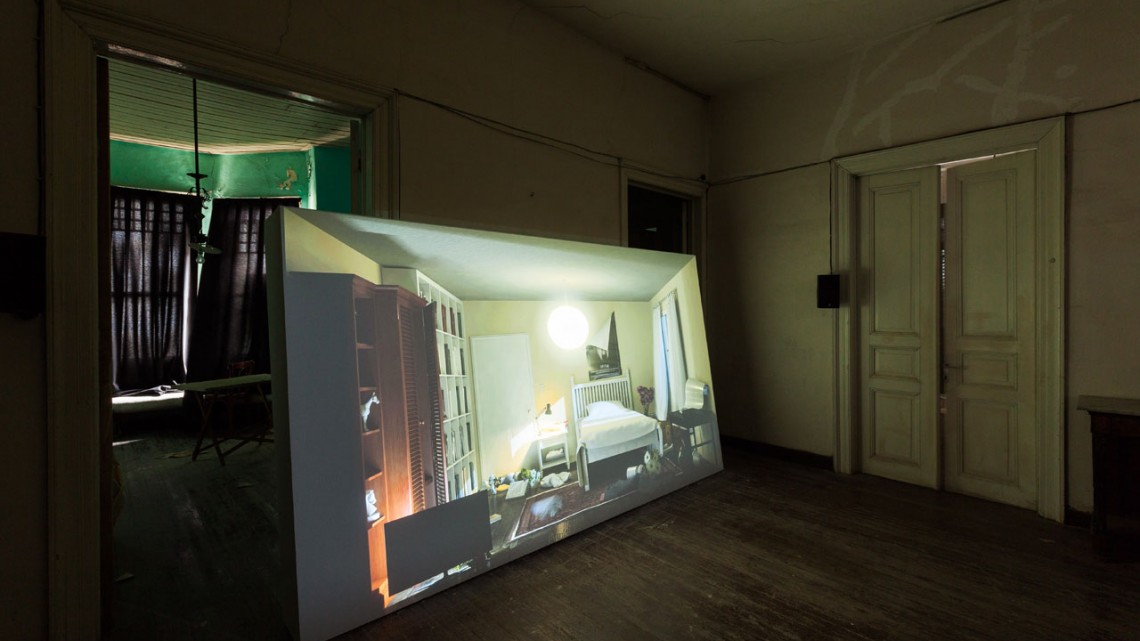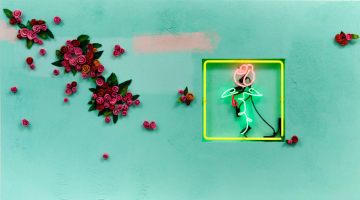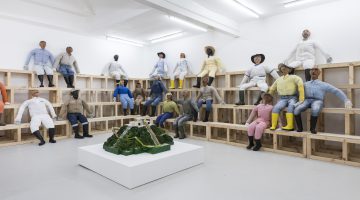An old, white fishing boat journeys up and down the Bosphorus from the Golden Horn and is seen from various places in Istanbul throughout the day. This is not just a boat among many, but an artwork containing a sound installation by Füsun Onur, one of Turkey’s most prominent early conceptual artists, who is little known outside the country. If you sit on the roof terrace of the Istanbul Modern museum for an hour or two, you might be able to see Sea (2015), yet most people had not seen it a month after the exhibition had opened to the public. This story encapsulates well the spirit of the 14th Istanbul Biennial, SALTWATER: A Theory of Thought Forms. While you might be able to see many things, you might as well not, and this depends not only on good luck but on your ability to read through a thick forest of invisible references and a highly theoretical, if not speculative, concept of art where aesthetic objects, reality, sites, and science meet rather haphazardly.
SALTWATER is rich in examples of the kind of speculative thinking that drives the ambitions of contemporary theory as a holistic apparatus of knowledge that ultimately becomes too abstract. A work by Lawrence Weiner, On the Verge (2015), is placed at a historical lighthouse in the coastal village of Rumeli Feneri, 25 kilometres away from metropolitan Istanbul, on the northwestern end of the Bosphorus Strait, and the work, described as “language and the materials referred to,” leaves the viewer slightly dumbfounded. Fernando García-Dory’s “para-institution,” under the name of INLAND Türkiye Extension Agency (2015), is an example of art as social practice, self-styled social sculpture, and propaganda space, but delivers little and bizarrely includes a shop. Pierre Huyghe’s Abyssal Plain (2015) is a concrete structure buried in the water on the island of Sivriada, and, again, is invisible to an audience that journeyed for two hours on a boat to an empty island in the Sea of Marmara.
Carolyn Christov-Bakargiev’s exhibition concept, which she has chosen to term a “draft,” revolves around saltwater, one of the most ubiquitous materials in the world and one fundamental to planetary life, looking at different types of waves and knots across seas and oceans as metaphors for movement and human agency. Saltwater is here deployed as the raw material of history in a city spread across different bodies of water. Hosted by dozens of venues in Istanbul—including traditional white cube spaces but also everything else from hotel rooms to private homes to islands to parking lots to lighthouses to the actual waters of the Bosphorus—the biennial is not one contiguous show but many solo presentations, only loosely interrelated and staged around a central exhibition (housed at the Istanbul Modern), in a complex network of relations between art and non-art, attempting to redefine a porous boundary between curatorial practices, exhibitions, archives, and theory.
Different species of movements and circulations—migrations across seas, blood flowing through our veins, movement of the stars, political transitions, revolutions—act as analytical models for knowledge types, overcoming the centrality of the aesthetic object and placing art in a larger symbolic order at the risk of fusing art with theory and losing both in an endless stream of metaphysical associations.
In a city like Istanbul, which is passing through a dangerous moment of transition and is at the heart of one of the world’s most convoluted regions, it is difficult to imagine how a discredited system of thought such as theosophy can serve as the cornerstone of this ambitious biennial edition, one that is traditionally highly political and strongly influenced by the post-Soviet world. But as is always the case with biennials, individual artists are sometimes able to respond to context more effectively than the grand narratives that command them—an often arbitrary theme crafted by a “curator”—making a case for art’s ability to resist its own mechanisms of authority.
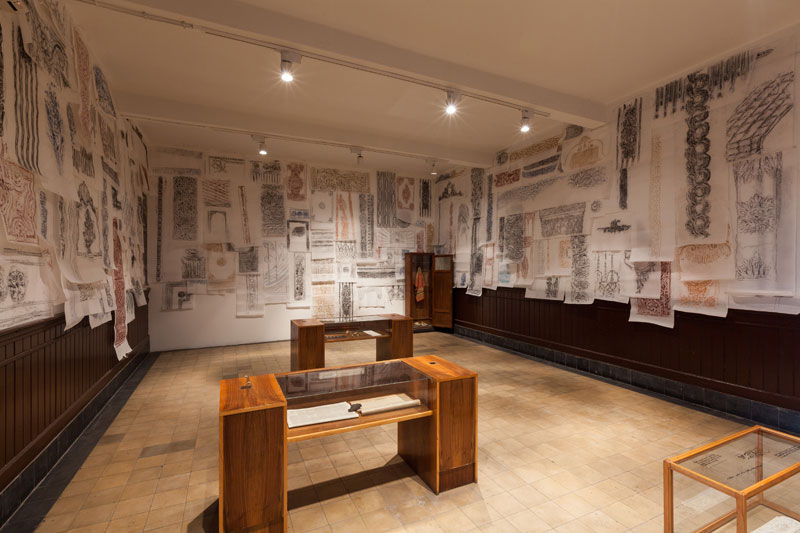
Michael Rakowitz, The Flesh Is Yours, The Bones Are Ours, 2015. Plaster molds, casts, dog skeletons from Sivriada, bones of livestock from dispossessed Armenian farms in Anatolia, fragments of lost Louis Sullivan building in Chicago, rubbings, photos, and letters. Photograph by Sahir Ugur Eren. Courtesy of IKSV.
Michael Rakowitz’s multi-room installation, The Flesh is Yours, The Bones are Ours (2015), is an investigation into the material history of Armenians in Istanbul, reproducing the art nouveau forms that adorned buildings in the period after the late-19th-century fires and earthquakes, when wooden houses were replaced by still-standing modernist structures at the hand of Armenian architects. The plaster of his work is mixed with ground bones from the island of Sivriada, where many stray dogs died of hunger in the 1910s after being transferred to the island, a chilling and almost surreal story that would be replicated in the persecution and extermination of Armenians during the genocide of the same decade. Rakowitz’s work is heterogeneous and compelling, but upon seeing it a couple of times it seems repetitive and a little forced. In the same building, the historical Galata Greek Primary School, a traditional biennial venue in Istanbul, with bitter references to the expulsion of minorities from the country, Haig Aivazian’s moving choreographed performance Wavy Wavy is the Sea of Bolis, O Mother (2015) took place only a couple of times with men from the Beyoğlu Holy Trinity Armenian Church Choir, addressing the creolization of Turkish and Armenian cultures. Paradoxically enough, it is in this building where the exhibition comes together best, even if it moves only in one direction: memory.
In any discussion about this biennial it seems crucial to ask why it was so important to have a large number of works addressing the Armenian genocide, either obliquely or directly: does the participation of an artist with an Armenian background imply already a reference to the genocide events of 1915 or at least to the historical process of recognition and reconciliation? For example, the visual history of salt trade by Anna Boghiguian or the paintings of Paul Guiragossian are not easy to cross-reference, except by a correlation of identity. On the other hand, the joint project of Ayreen Anastas and Rene Gabri called Multi-storied Houses (2015), located in the office of the late Hrant Dink (an Armenian-Turkish intellectual assassinated in 2007), connects with Rakowitz’s by dealing with the role of Armenians as photographers in the Ottoman Empire, and presents a beautiful assembly of objects and memories in the form of a puzzle waiting, almost hopelessly, to be deciphered.
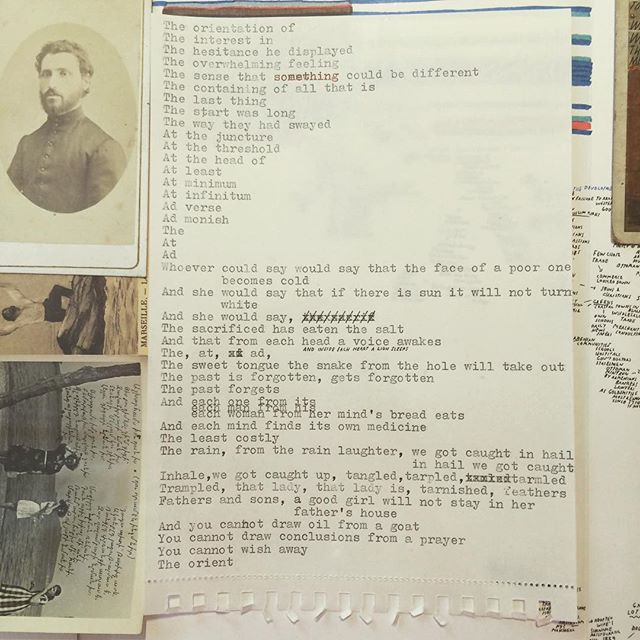
Ayreen Anastas & Rene Gabri, Multi-Storied Houses; Stables; Folds and Barns; Farms and Summer Homes; Lands and Fields of Villages; Destroyed Vineyards, Orchards and Vegetable Gardens; Churches; Chapels and Shrines; Par- ish Schools; Mills; Areas of Forest, etc…, 2015. Ink, pencil, eraser, pastel on paper, various other materials, and video. Photograph by Sahir Ugur Eren. Courtesy of IKSV.
Hera Büyüktaşçıyan’s project The Open School, though it has received little attention, is perhaps one of the most effective knots in this movement of waves between histories and places. It begins as a preoccupation with the re-activation of a space, gathering an archive of books, notes, and objects from the original Greek school at the time of its functioning; the items are displayed in the reading room alongside a number of notebooks in lieu of the original number of students. Islands Speaking has been a cycle of weekly readings held in the room, bringing together a number of languages, speakers, and themes along the shores of islands (Büyüktaşçıyan lives on one of the Prince Islands of Istanbul). Thinking about the island as metaphor for displacement, isolation, insulation, alienation, but also the much-needed shelter of the private domain, intimacy, and inwardness, how does one speak like an island in an archipelago of temporal variations and spatial confusions?
On the second week of October, The Open School hosted Turkish sociologist and art historian Pelin Tan, whose work is also showing at the biennial with Anton Vidokle, and who spoke at length about different types of islands and archipelagos, the Israeli blockade on the Palestinian territories, the military rule throughout Kurdish cities east of Turkey, political and cultural movements outside their times, how to fundamentally reframe the relationship between artifacts and time, enabling the possibility of there being forms that do not belong to any specific timeframe. The action of a public reading in a space that has long been considered to have ceased to exist introduces an aural aspect of reverberation, as if the angular frequency of waves could grow exponentially over a period of time. Yet this time is not pure, abstract, or ahistorical; it belongs with familiar objects and knows the process of decay in all living matter.
The memorialization of the Armenian genocide as a whole is a very easy strategy out of the gray zones of Turkish history that the exhibition looks at touristically, almost as circumstantial events captured by the lens. The easiness is derived from the distance that exists between the genocide and our own time, so that that it becomes possible to address a history that is no longer present. But while this theme is overbearing, the crude realities of the country today, from the Kurdish problem to the Syrian war to the new fundamentalisms, remain largely absent. One should not expect differently from a biennial, for the present presses so closely that it suffocates any attempt at representation, but the narrative of movements across time seems incomplete without assimilating the whole of reality’s tissue, in the same way that the exhibition wants to swallow the entire city and becomes consumed by it.
The eight sites on Büyükada and Sivriada, two of the Prince Islands, reveal the difficulties of this imperial mode of curating that assimilates not only institutions but also entire topographies and bodies of water. William Kentridge’s O Sentimental Machine (2015) is a mesmerizing tale about Leon Trotsky’s exile on the island, through the exchange of letters and a utopian program, but pales in comparison with the rest of Kentridge’s oeuvre. The different black and white screens appear contrived in their setting—an entire floor of the sumptuous Splendid Palace Hotel, with its red carpet and art deco motifs that deprive the work of its cinematic qualities. One of the most highly publicized works in the show is the monumental sculptures by Adrián Villar Rojas, The Most Beautiful of All Mothers (2015), set right on the water, which appear majestic as you exit the garden of the dilapidated house where Trotsky lived. The work has a sense of the spectacular, but could it have succeeded in a different venue? Closing the biennial with this work seems in stark contradiction with the open-ended attitude, and sets the same monumentality it attempts to disestablish, as an event horizon that cannot be crossed.
A number of critics and journalists, often disingenuously, read Villar Rojas’s sculptures against the background of the bodies of Syrian children washing ashore on the coasts of Turkey. His life-size fiberglass sculptures, combined with organic and inorganic materials atop, form a Noah’s Ark going in the opposite direction, as if moving towards the dry land, or returning from mythology to the uncertainties of history. Still, one is left feeling that despite the immensity of the show in terms of both its scale and the geographical area it comprises, from the Black Sea through the Bosphorus and the Marmara, one is still hungry for more art.
Ed Atkin’s digital film Hisser (2015), set on the ruined Rizzo Palace, delivers a powerful shock that sets it apart from all the background noise of institutional art. Based on a news story from a Florida man that fell into a sinkhole while he slept, the film recounts the last thirty minutes of his life. As the man falls into the hole after a long sequence of sobs, anxieties, and obsessive behaviors, the sound becomes louder and louder and the dilapidated palace begins to shake. For many in Istanbul, Atkins was, accidentally, the centerpiece of the biennial; the shaking house of the Turkish republic finds itself now at a turning point, in between the threat of looming war in the region, internal turmoil, decelerating economy, and, above everything, uncertainty. Back on the mainland, the central exhibition at Istanbul Modern is a serious disappointment, with an eclectic combination of artwork that does not coalesce, and that does not feel poignant. Marwan Rechmaoui’s pillars are elegantly executed and remind one of the artist’s earlier mapping of Beirut, leaving a striking impression, but are somewhat disjointed from the rest of the show, as are works like the paintings of Fahrelnissa Zeid or Paul Guiragossian.
The Channel, in which Christov-Bakargiev deploys the full extent of her curatorial alchemy, is a self-standing exhibition at the heart of the biennial that operates independently of the rest and is replete with obscure references to science. Being one of the finest exercises in intellectual history and curatorial power that an Istanbul Biennial has witnessed, there’s very little art in it: books of Charles Darwin, pages from Lacan’s drawings, the neuron drawings of Santiago Ramón y Cajal, copies of Annie Besant’s sketches, the vases of the botanist Émille Gallé.
SALTWATER: A Theory of Thought Forms, takes its cue from the once-popular Thought Forms book by late-19th-century English theosophist Annie Besant, present in the exhibition through copies of her drawings in The Channel and the original book placed alongside the unremarkable artist’s book of Merve Kılıçer’s, whose work is said to precede European abstraction and refers to materialized thought that has taken physical form, so that the vibrations and movements of our body in the world create a variety of forms that are then materialized through movement. However interesting, the reference to Besant seems antiquated and vague in this context.
The interest in this biennial arises not necessarily from its many complications, but from certain points of contact that emerge on the margins of these complications and establish newer, increasingly dynamic relationships that do not yet form a consistent whole; they stay at the level of forms, from which one is compelled to conjure up his own magic.
This is not necessarily a weakness in the broader understanding of what art can do versus the political, but it is too fragile and superficial a survey of the possibilities afforded by Istanbul. In the 11th century, Europeans looked at Constantinople with eyes of desire—Wael Shawky’s film Cabaret Crusades, The Secrets of Karbala (2015), screened in a historical hamam from the 15th century, tells the story of the crusades in reverse, seen through the eyes of the Arabs, Constantinople is portrayed as a wealthy city at the gates of a new world, an architectural marvel, and the seat of an empire. Underlying this image, however, the Byzantine Empire was an unstable house of intrigues, conspiracies, and political deadlocks. In that regard, Istanbul is still very Byzantine: an excessively complicated, intricate maze of failing bureaucracies and growing tensions. But the image projected on the wall of the city, facing Europe, was enough for the impoverished Europeans to sail on boats and vessels to besiege Constantinople.
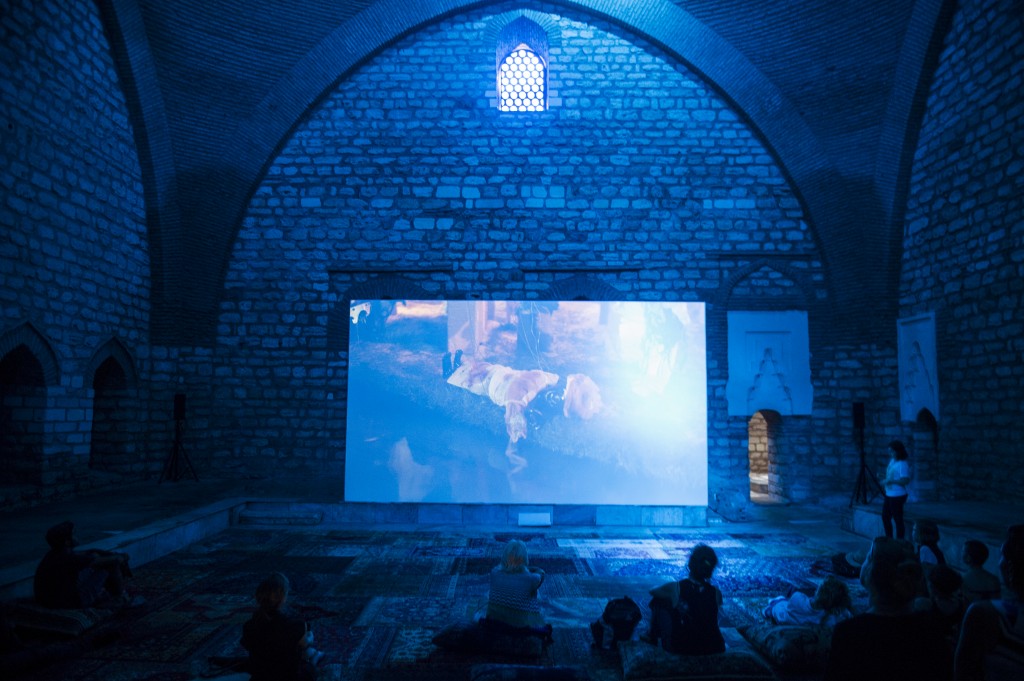
Wael Shawky, Cabaret Crusades: The Secret of Karbala, 2015. Installation with projection in HD video, liquid tar, clay, cement, wool, marble, and hand blown Murano glass marionettes. Photograph by Ilgun Erarslan Yanmaz. Courtesy of IKSV.
Yet visitors today are still in awe at the sights of the city, as if they were still staring at an image projected on a wall, forbidden from entering this curious passage of time that connects all that glorious past with a present space. This image, which no longer existing in its original form as many sections were dismantled in the 19th century, splits into different images projected on many other interior walls. But behind this synchronized spectacle lies a seat of authoritarianism, the result of several decades of dictatorship and chaos, attempting to raise its head above water with the help of neoliberalism. The kind of soft power deployed to transform an ailing space into an image of the future is not unique to Istanbul: I am speaking here of art that exists only in a state of suspension, or as a future imperfect tense; a reference to the past that expresses an unfinished, ongoing action.
The 14th Istanbul Biennial is one great example of such soft power. While it does not attempt to cover up the glaring facts on the ground, and in fact highlights their omnipresence, the many exhibitions in the biennial create a parallel universe of loosely interconnected bodies gravitating around each other: a universe far greater than the facts themselves so that they are ultimately suffocated by the grandiose show. This species of time, an ever-expanding timeless future, is made possible only at the expense of the present and has to be safely anchored in a past that is either no longer tangible or already too solid to become streamlined with the measurements of the here and now. This is a phenomenon taking place in all major institutional shows in the art world from Venice to Sharjah to São Paulo.
As biennials are hardly able to fund themselves, they are growing far and away from academic shows, forced to compete with galleries and art fairs. Perhaps this also means that from now on there will no longer be any excellent biennials, unless they agree to operate as an extension of the marketplace. This new philosophy of abstraction and vagueness behind exhibitions, sensorial more than it is representational, is so highly politicized—rather than political—because it is essentially homogeneous and powerless, tackling otherness and conflict only from a very safe academic distance. If the purpose behind this edition of the Istanbul Biennial was to showcase our current state of confusion and shock at the new political realities of this country, through a labyrinthine maze of metaphors and events, then it is clearly very successful. Deep down, however, we do not turn to art in order to speak for the obvious, but rather in order to make sense of bigger questions about the possibilities of human agency in a convoluted world. As the Hungarian philosopher Ágnes Heller put it, “the goodness of the message of art does not always translate into goodness of art.”
Endnote
On the morning of October 10, as this article was being edited, an explosion shook the Turkish capital Ankara with a blast that cut short the life of more than 100 people participating in a peace rally. The courts placed a temporary gag order on investigations into the deadliest terror attack on modern Turkey, and so far a list of suspects remains elusive; hard to believe in a state of mass surveillance. With six different tragic scenarios since 2011 that have taken a toll of nearly 600 lives, there has not been a single resignation of a government official. And this is the way we live now. On the evening of September 1, as MOMA PS1 offered a cocktail party on the roof of Soho House to honor the biennial curator, tear gas rained down on the streets after a peaceful demonstration, marring many gallery openings taking place that night. The director of an art institution in the region remarked that the government was engaged in a war against the people, not being aware that since the events of Gezi Park in 2013, such scenarios of confrontation and violence have become part of a weekly routine in Istanbul. In this state of increasing confusion, it would be difficult to tell what kind of criticality or engagement is required from art and its institutions, but a commitment to the politics of the here-and-now, with all its ugliness and disenchantments, could be the first step.
